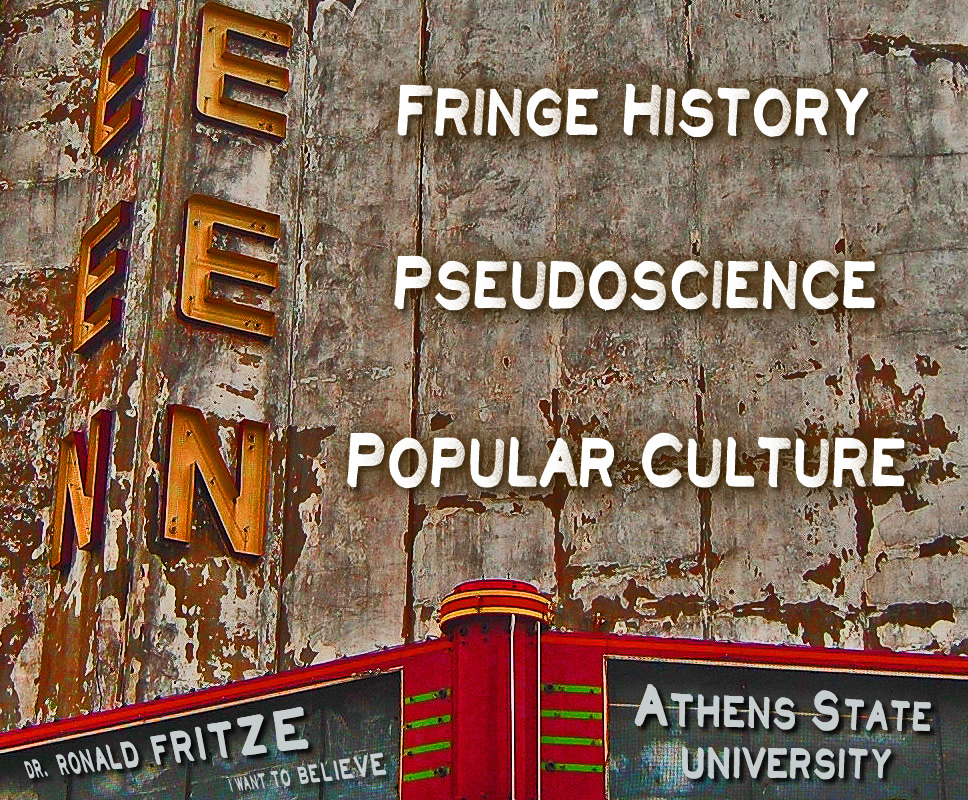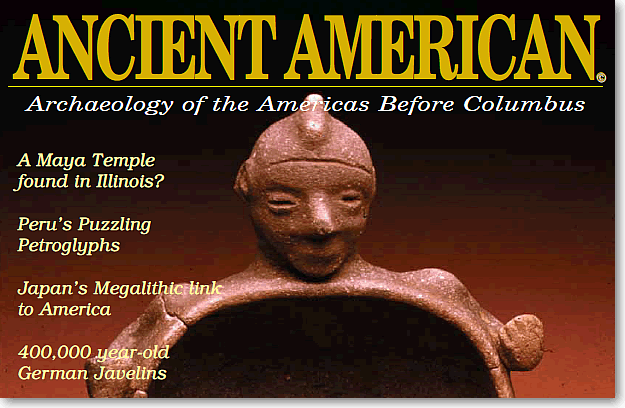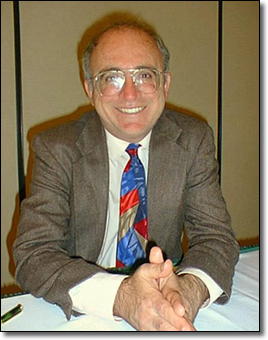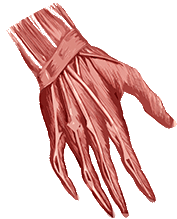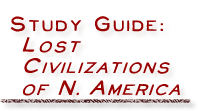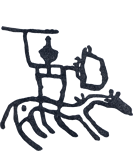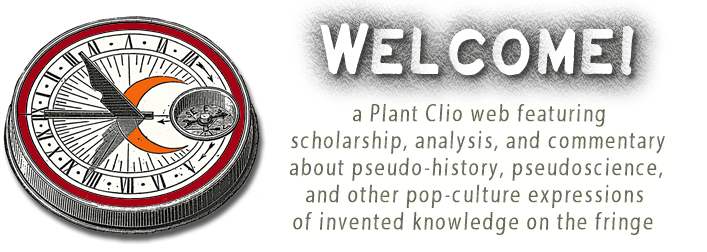

My Day among the Pseudo-Historians.
The Fringe Scholars Come to Fort Wayne
Via the Ancient Mysteries Conference.
(Can I Interest You in a Coney Island Hot Dog?)
Wonder is the daughter of ignorance.
The greater the cause inspiring it,
the greater the wonder
— Giambattista Vico, New Science (1725)
By Ronald Fritze
Posted on Monday, June 17, 2013, from Athens, Alabama
Regular readers of Planet Clio know that one of my scholarly interests is studying the phenomenon of fringe scholarship. New readers might be wondering what this “fringe scholarship” is all about. Well, like the demonic spirit in possession of the Gadarene man in Mark 5:9, fringe scholarship could rightly say, “My name is legion, for we are many.”
Fringe scholarship goes by various names: alternative scholarship, alternative history, alternative science, rejected knowledge, stigmatized knowledge, forbidden knowledge. Adherents of fringe scholarship tend to like the forbidden knowledge moniker. After all, most things forbidden are intriguing, and seductive — a guilty pleasure. More judgmentally — which is not to say inaccurately — mainstream scholars refer to fringe scholarship as pseudo-history, pseudo-archaeology, or pseudoscience.
But how, exactly, can “fringe scholarship” be defined? It’s slippery, the definition, but a good example of the phenomenon is the stuff presented as legitimate theory by the television series Ancient Aliens. Now that is fringe scholarship in action. And if you believe that Ancient Aliens is based on valid information, then you need to take a look at www.ancientaliensdebunked.com .
It's about as Legit as South Park.
Yes, Ancient Aliens is a smartly produced television show in a technical and stylistic sense. In format, it looks like any other indubitably legitimate documentary. But the content is another story entirely. No legitimate mainstream scholar accepts the conclusions presented by Ancient Aliens. For that matter, neither do the people who produce South Park. So, if you want a good laugh, check out South Park’s send-up of Ancient Aliens. You can find a Wikipedia article on the South Park episode, “A History Channel Thanksgiving,” which includes a link to the video. 1
Ancient Aliens imitates legitimate documentaries. In fact, the producers are provided with the privileged position of being a recurring series of five seasons and counting to its credit on the History Channel. Not bad for baloney. The fact is, fringe scholarship imitates mainstream scholarship. Its books often imitate the format of scholarly books with footnotes and bibliographies. Its publications look like scholarly journals and its magazines look like reputable popular magazines. Martin Luther once commented that “Where God builds a church, the Devil builds a chapel.” It would not be much of an exaggeration to say that wherever mainstream scholarship builds a church, fringe scholarship builds a chapel.
Mainstream scholars and fringe scholars don’t get to mingle too much. But that changed for me recently. About a year ago I was up in my hometown of Fort Wayne, Indiana, to visit my Mom. Whenever I visit Fort Wayne, I make an obligatory pilgrimage to Hyde Brothers Books on Wells Street. I am a bibliophile — some might say bibliomaniac. My loving wife Twylia would say obsessive/compulsive jerk when it comes to used bookstores. Hyde Brothers is one of the finest used bookstores out there — not as large as the Strand in New York, but the Strand is so big it overwhelms me. Anyway, if you are a bibliophile (bibliomaniac?) check it out. You’ll like it.
The owner, Sam Hyde, knows of my interest in pseudo-history. Last summer he told me about this group Ancient Mysteries International, said they were having a conference in Fort Wayne, but it was taking place in September so I had to miss it. Home again at Christmas, I listened as Sam tipped me off that Ancient Mysteries International was having another meeting on 13 April 2013. It worked out that I was able to combine a visit at my Mom's with attendance at the conference.

Go to the Truck Stop and Park Your Credulity.
I had no idea what to expect. Registration was $75 in advance, $90 after 30 March — not bad as conferences go. Ancient Mysteries International booked the conference at the Clarion Hotel along the old bypass highway in an area cluttered with truck stops. Though I’d visited home regularly since 1970, I realized I wasn’t familiar with Fort Wayne hotels, so it took a while to find my way. No big deal. I made it just in time.
Bruce Cunningham, principal organizer, was there to greet us. I'd met him two days earlier at Hyde Brothers. A pleasant guy, Bruce exhibits great enthusiasm for fringe theories of the ancient past, an enthusiasm apparently devoid of any critical assessment of the theories or any skepticism about them. The conference folder included a slip of paper that stated: “ANCIENT MYSTERIES INTERNATIONAL’S MISSION: To promote and support the many people who research and are interested in the multitude of Ancient Mysteries of Ancient Peoples, Places, Structures, and other Phenomenon of the past and our time today.” I could hardly wait. Do not record the presentations, we were told — and save your questions until the end of each talk.
Five talks provided the meat of the conference. As I looked around the room waiting for the first talk to begin at 8:30, I counted a few more over thirty in the room, about 80 percent male and all white — apparently fringe scholarship is not big with African-American adherents to the cause, unless you are talking Nation of Islam and extreme Afrocentrism. Almost everyone was aged forty or above, although there were a few younger guys. By the second talk, the audience had grown to almost forty, and by the afternoon sessions, attendance numbered in the mid-forties — not a big conference in terms of attendance.
It All Began with the Ur-Vedic Masters:
Flying Machines, Atomic Wars, Square Roots, and Pi.
Stephen Knapp, the first speaker, waded into a presentation entitled “Proof of Ancient Vedic Culture’s Global Influence.” I’d not heard of this guy, but based on the content of his talk, he just had to be a close associate of Michael Cremo, one of the pseudo-universe’s superstars (more about Cremo later). Vedic theories, derived from the myths of the Hindus, claim that human civilizations began hundreds of thousands and even millions of years ago. Although these theories are anti-Darwinian, they hardly give aid and comfort to traditional Judeo-Christian cosmogony, which posits a young earth aged six thousand years or thereabouts.
Vedic theories assert the existence of Vimana flying machines, laser-like weapons, and even atomic warfare. Knapp avoided those aspects of the theory, choosing instead to make his case for the global influence of Vedic culture. In other words, Vedic culture was the ur-civilization of humanity, i.e., the original or first. According to Knapp, evidence shows that the ancient Vedic culture knew the concepts of square root, zero, pi, and the Pythagorean Theorem. Other human civilizations, he said, are the result of hyper-diffusionism from the Vedic culture.
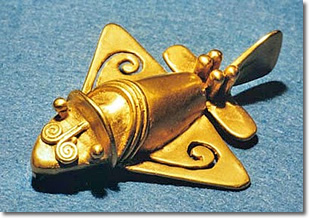
A web named UFO-Contact claims this image is an "actual vimana flying machine scale model found in archeological dig."
Sadly, Knapp’s talk included the usual whines about misinformation coming out of academia and the mainstream media. His whining holds little weight when you consider the History Channel’s frequent airing of Ancient Aliens and American Unearthed, both fringe scholarship wonderlands. Their broadcast is anathema to the tired old claim that alternative scholarship is ignored by mainstream media. Knapp’s talk also seemed to suggest that the Aryan Invasion theory of Indian history remains the dominant paradigm among mainstream scholars of the history of ancient India, which has not been the case for something like fifty, maybe sixty years — and I might be being generous to Knapp with the timeline.
Actually, We Owe It All to a Hardy Band from Lemuria.
Frank Joseph gave the next talk, “Origins of Mankind’s Culture before Atlantis.” Short, bald, and neatly dressed in a nice suit, Joseph spoke about Lemuria, the lost continent of the Pacific and Indian Oceans that supposedly pre-dated Atlantis, hence the title of his presentation. Various Pacific sites were discussed, including Nom Madol, an ancient basalt city located on a remote Indonesian island — so remote that Joseph has not been able to visit it just yet. The sunken “ruins” at Yonaguni were brought into the discussion as well as a radical re-dating of the habitation of Easter Island by David Childress and Robert Shoch, two front-line writers of fringe history.
According to Joseph, about seventy-five to eighty thousand years ago, the Mount Toba volcano erupted and almost caused the extinction of humans. Only a small group of about two thousand couples survived the catastrophe. All human civilization originated with this group. Later, Joseph presented a totally upside-down etymology for the term Lemuria and made the claim that the Romans believed in the existence of Lemuria. Nice man, but his talk was rambling and disorganized with lots of misinformation, which included the usual complaint that mainstream scholars are closed-minded to fringe theories.
Don't Look for the Dog-Headed Men in Hopi Land.
They've All Gone to China. Or Somewhere.
The "archaeo-astronomer" of the American Southwest can be found at The Orion Zone.
Up third was Gary David, self-proclaimed expert on the “Ancient Mysteries of the Desert Southwest.” His talk was even more rambling than the previous two. David asserted Egyptian influences on the Hopis and cited inspiration from Robert Bauvel’s Orion Mystery. Like the three pyramids of Gizeh, the placement of Hopi villages corresponded to the Orion constellation. And we all thought it was probably related to the water supply.
Henrietta Mertz’s Pale Ink is cited to prove early Chinese visits to the Southwest. Sure, Mertz believes her theory, but there is no compelling evidence for it. David also mentions stories of dog-headed men. The problem is that everybody believed in the existence of dog-headed men. They were always located someplace else far away. Medieval Christian monks visiting courts of Mongol khans looked for dog-headed men in Asia. But much to their surprise, Chinese emissaries asked them about sightings of dog-heads in the West. To complete the lack of focus, David discussed a Masonic connection with Phoenix. Good stuff for my interest in Egyptomania but not rigorous history.
Jaredites, Nephites, and the East Star Man
At that point, the group broke for lunch. It was about one o’clock but still not late enough for me to miss the midday rush at the nearest Panera Bread. When we resumed at two, Wayne May, the publisher of the magazine Ancient American, presented on the topic of “In Search of Ancient Mormons and the East Star Man.” May was a talking head on the documentary Lost Civilizations of North America. (He’s grown a beard since the film was made.) Lost Civilizations of North America is a Glenn Beck extravaganza that provides covert support for the Book of Mormon’s version of the pre-Columbian history of the Americas.
Wayne May is editor of this magazine,
devoted to "Archaeology of the Americas Before Columbus."
May is a pleasant and well-spoken man. Listening to his presentation, I became convinced that he follows traditional Mormon theology. The theories he and Beck present do not agree with theories developed by Mormon archaeologists working in Central America. These new theories attempt to harmonize the Book of Mormon story with the existing archaeological record. Despite their best efforts, the new Mormon archaeologists have not convinced mainstream archaeologists and historians of pre-Columbian America. But their ideas are still a lot more plausible than the traditional Mormon version.
According to May, the Jaredites, who were the most ancient settlers of the Americas, were large in stature. The Nephites, the later Hebrew settlers, are identified with the Hopewell culture, an assertion that doesn’t work all that well with the current radio-carbon-based chronology of American prehistory. May further claims that the Newark Holy Stones and the Bat Creek artifacts are genuine, something reputable archaeologists would reject.
Other claims include the existence of pre-Columbian elephants and horses. Now there are lots of tales about pre-Columbian elephants, which some have suggested may have been holdouts of mammoths and mastodons on the verge of extinction. But pre-Columbian horses, except for the prehistoric Eohippus, that was a new one for me. There was a lot more to May’s talk. I can’t say that I agree with any of it, but he was better organized, more focused, and more specific than the previous three presenters. I bought a couple of reprints of outdated nineteenth century archaeological books from him. As I said, Wayne May is a pleasant man who knows his stuff, even if it is not necessarily the right stuff.
The Cremo of the Crop
Opens His Door into Forbidden Archeology.
Michael Cremo, biggest name among the five, took center stage as the final speaker of the day. If you watch Ancient Aliens, you have probably seen Cremo as he is a frequent talking head on the show. He is best known for a massive 914-page tome titled Forbidden Archeology: The Hidden History of the Human Race, which came out in 1993. Not surprisingly, his talk was called “Forbidden Archeology and More.” Like May, Cremo is a good speaker and his material is well organized. He appears to have lost some weight since he first appeared on Ancient Aliens, but he is still readily recognizable.
Cremo started off his talk with the statement that Fort Wayne is becoming a center of alternative history. As a loyal scion of Fort Wayne, I thought for a moment
 about the implications of Cremo's observation, and I was somewhat ambivalent about whether it's good to be at the center of this particular vortex. There are lots of better things for Fort Wayne to be known for. Johnny Appleseed is buried there, although he’s buried at a couple of other places, too. The Allen County Public Library has one of the finest genealogical collections in the country. And the Coney Island Hot Dog Stand on Main Street will hit is 100th anniversary in 2014.
about the implications of Cremo's observation, and I was somewhat ambivalent about whether it's good to be at the center of this particular vortex. There are lots of better things for Fort Wayne to be known for. Johnny Appleseed is buried there, although he’s buried at a couple of other places, too. The Allen County Public Library has one of the finest genealogical collections in the country. And the Coney Island Hot Dog Stand on Main Street will hit is 100th anniversary in 2014.
My Dad introduced me to the hot-dog stand when I was a little kid. He ate hot dogs there when he was a teenager. I try to go there at least once every time I am Fort Wayne. I like the dogs and the chili, but I also go because it is something I shared with my Dad. Then there is the Fort Wayne Komet hockey team — and let’s not forget that fine Hyde Brothers Bookstore. But alternative history . . . ?
OOPARTS Hold the Key to Cremo's Hidden Evidence.
Cremo, who is associated with the Bhaktivedanta Institute, is another Vedic scholar pushing a Hindu worldview. Like Knapp, who gave the first paper, Cremo is an advocate of Vedic culture and the extreme antiquity of humanity. Again, he is anti-Darwinian, but it is hard to see how a conscientious Creationist or Intelligent Design advocate could make a common cause with Cremo. Critics of Cremo’s theories ask where is the archaeological evidence for the existence of the extremely old human societies? Cremo’s answer is that the evidence is there, but it has been ignored and suppressed by mainstream scholars. Especially ignored and suppressed are out-of-place artifacts, aka OOPARTS. These are the anomalies supposedly found in coal mines and other isolated places. Cremo claims that discoveries of OOPARTS have been ignored or marginalized in the secondary literature of science. He further contends that the scholars who made the discoveries have been ostracized.
Cremo is the rare fringe scholar who has some peer-reviewed academic publications. They are not, however, publications that directly address the Vedic theories of the extreme age of modern humans. Instead, in the course of researching old scientific publications for discoveries of OOPARTS, Cremo was also doing a lot of detailed research into the history of geology and other sciences. His refereed publications are micro-histories or case-studies of various episodes in the history of science. As such they are good history, but they by no means prove the contentions of the Vedic culture theorists. Cremo has gathered these papers into a book, My Science, My Religion: Academic Papers (1994-2009). I paged through the book at a display table at the conference. Now I am regretting not buying it, although it is for sale at Amazom.com. Cremo is a several cuts above the typical author of fringe scholarship, despite the rather exotic theories that he advocates.
Cremo’s paper brought the conference to a close. I wondered about perception and reality, about fact and fantasy — about why people showed up. The presenters and most of the audience appeared to be normal enough. I was sitting near a couple of women, and I thought I heard one of them refer to their being teachers. Why were they there? I attended because the subject matter fits my scholarly agenda and provides field research on fringe history and popular culture. A few in the audience looked and behaved like they definitely belonged on some fringe … somewhere … along a timeline all their own.
Why?
Out in the exhibits area some guy was hawking a few monetary conspiracy books. Based on the conversations I overhead, attendees of the conference shared a strong suspicion of Wall Street and big banks. Why not? Given the events of the Dubbya presidency and our continuing financial pickle, the monetary conspiracy guys might not be major nutjobs after all.
It was a good learning experience for me to put a human face to fringe scholarship. Whether or not their ideas hold water, these folks are earnest human beings, not punching bags for academic condescension. Bruce Cunningham, the organizer of the conference, was a pleasure to meet. His exuberance is refreshing. I gather that his interest in fringe scholarship is something that began fairly recently, perhaps in the past five to ten years. He is widely familiar with various theories and writers but seems blithely unaware that they can’t all be true. Many of the fringe theories contradict each other far more than they contradict mainstream scholarship.
I heard the usual complaints about mainstream scholars, but why would we expect otherwise? Other than Sam Hyde, no one there recognized my name, which means none of them have read my books. And that hurts, but at least I didn’t have to attend the conference incognito. Would I attend another such conference? Oh yes. Bruce Cunningham is planning another on 14 and 15 September. If I can make it back to Fort Wayne, the burgeoning capital of alternative history, I will be there.
We understand nothing of the works of God,
if we do not take as a Principle
that He has will to blind some and enlighten others.
— Blaise Pascal, Pensees
Yes, I am citing Wikipedia. But where else can you find reliable references to a South Park episode? Also, I am not a South Park watcher. My students told me about “A History Channel Thanksgiving” — teachers can learn some pretty good stuff from their students. Education is a two-way street and always has been.
![]()

